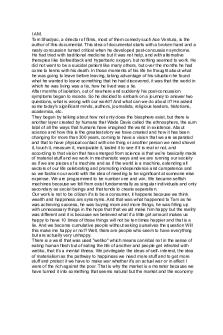Daniel Dennett Where Am I HW Response PDF

| Title | Daniel Dennett Where Am I HW Response |
|---|---|
| Course | Intro to Philosophy |
| Institution | Tulane University |
| Pages | 2 |
| File Size | 55.8 KB |
| File Type | |
| Total Downloads | 26 |
| Total Views | 158 |
Summary
reading response - Prof. Kaleena Stoddard...
Description
Zoe Green PHIL1010-01 Daniel Dennett: Where Am I? HW Response
In Daniel Dennett’s text Where Am I?, Dennet asks himself the question, "Where am I?" after his operation in which he considers there to be three possible answers. The first is that he is where his brain is. However, he did not actually think that his brain was imprisoned or stuck since he still felt free as long as his physical body was not imprisoned. The second is that he is actually with his body. The argument against this is that Dennett believes it is possible to be able to switch bodies and that it does not seem to matter for one's identity. The third is that he is wherever he thinks he is. The main problem with this is that you can often be mistaken about where you are and make mistakes with that idea mentally. When Dennett talks about losing contact with his body while he is underground, he continues the thought experiment as if he takes on the point of view of a brain in a vat that has no sensory perception at all. I think that this perspective is coherent because Dennett is still able to create a world within his own mind and can convince himself so that he will truly believe that he is there even if he physically is not. Someone can still be conscious without a body in a multitude of cases, as well, we just may not able to know it or understand it unless we are witnessing it ourselves. One thing that comes to mind for me is the experience of sleep paralysis. Even though someone cannot physically move around and experience the physical world, their mind is still conscious and fully functioning despite their immobility. This comparison doesn’t perfectly line up to the idea of not having a body, but it is a fairly close, real-life example that has been proven to be true. I don’t think that it’s plausible to suppose that the Hubert-Fortinbras pair really is Dennett. This is because,
although the pair is made up of exact replicas of Dennett’s brain and body, it still remains only a replica of Dennett. No matter how impressive or identical to Dennett the replica pair may be, it can still not be considered to actually be Dennett unless it uses his actual brain and his actual body that he was born with; replications are different things with resembling features. If Yorick is the brain and Hamlet is the body, then I think Dennett must be the soul or conscious of the being. At the end of the article, Dennett claims that one of the brains gets “out of synch” with the other brain and hence feels like a prisoner in his own body. By this, I think Dennett means that the synchronicity of the two brains working together in harmony for all of his life was something that Dennett really appreciated and felt that he benefited from in terms of feeling free and independent. When the two brains got “out of synch” with one another, however, Dennett lost that feeling that he knew so well and learned to appreciate and live with. Now with this new adjustment that he has to make to his life, Dennett is not a fan of the way things work for him now and doesn’t feel like he is living in his own body anymore; he feels like a prisoner in his own body because it no longer feels like the one he grew to know and love. Both Yorick and Hamlet are physical parts of the being that facilitate bodily functions both physically and mentally for the being to exist successfully. While these are both especially key parts for the being to survive, the one crucial part that is left of the being that has not been considered would be the conscious or the soul of the being....
Similar Free PDFs

Daniel Dennett Lecture Notes
- 1 Pages

Ensayo I AM SAM
- 3 Pages

Thomas Nagel Death HW Response
- 2 Pages
![[Template] Who am I](https://pdfedu.com/img/crop/172x258/6n3e9lyvq625.jpg)
[Template] Who am I
- 2 Pages

I am a rock - Poem
- 1 Pages

I AM SAM Movie Reflection
- 2 Pages

Gary Okihiro When and Where I Enter
- 21 Pages
Popular Institutions
- Tinajero National High School - Annex
- Politeknik Caltex Riau
- Yokohama City University
- SGT University
- University of Al-Qadisiyah
- Divine Word College of Vigan
- Techniek College Rotterdam
- Universidade de Santiago
- Universiti Teknologi MARA Cawangan Johor Kampus Pasir Gudang
- Poltekkes Kemenkes Yogyakarta
- Baguio City National High School
- Colegio san marcos
- preparatoria uno
- Centro de Bachillerato Tecnológico Industrial y de Servicios No. 107
- Dalian Maritime University
- Quang Trung Secondary School
- Colegio Tecnológico en Informática
- Corporación Regional de Educación Superior
- Grupo CEDVA
- Dar Al Uloom University
- Centro de Estudios Preuniversitarios de la Universidad Nacional de Ingeniería
- 上智大学
- Aakash International School, Nuna Majara
- San Felipe Neri Catholic School
- Kang Chiao International School - New Taipei City
- Misamis Occidental National High School
- Institución Educativa Escuela Normal Juan Ladrilleros
- Kolehiyo ng Pantukan
- Batanes State College
- Instituto Continental
- Sekolah Menengah Kejuruan Kesehatan Kaltara (Tarakan)
- Colegio de La Inmaculada Concepcion - Cebu








